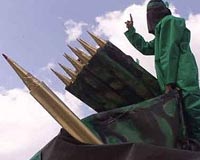 |
Cairo (UPI) May 10, 2011 NATO airstrikes Tuesday on Moammar Gadhafi's Tripoli compound, the second such attack in 10 days, have reinforced the suspicion that Western powers are out to assassinate the Libyan leader. Western leaders deny that but admit they're seeking regime change. It's not just the missile attacks by NATO jets that make it look like Gadhafi's the target. The recent deployment of missile-firing unmanned aerial vehicles, like the ones the Americans are using in Pakistan and Afghanistan to kill militants, has put in place a potent weapon designed to kill high-value targets. And the May 2 killing of al-Qaida leader Osama bin Laden by U.S. Navy SEALs in Pakistan must have given Gadhafi, who for most of the last three decades was reviled as "the mad dog of the Middle East," pause for thought. Indeed, Gen. David Richards, chief of the British Defense Staff, declared four days after bin Laden was killed that shooting the al-Qaida leader was "definitely a positive" in the context of bringing about political change in the Middle East. "It will remind like-minded people wherever they" -- read Gadhafi -- "are that one day their deeds will catch up with them. "That's psychologically very important in the contest of Libya and other crises in the Middle East, so I think it's a psychological impact rather than a short-term impact," he said. Top NATO and U.S. officials insist that Gadhafi isn't being deliberately targeted on the grounds that a state of war doesn't exist between these powers and the quirky, unpredictable Libyan leader who for years was branded a supporter of international terrorism. But British Defense Secretary Liam Fox said in April that the alliance was launching attacks on Tripoli "to increase the psychological pressure on Gadhafi." The details of Tuesday's missile strike on Gadhafi's Bab al-Azizya compound are sketchy but in an April 30 airstrike on the same complex in Tripoli's upscale Gharghour district, the Libyans claimed the youngest of Gadhafi's seven sons, Saif, 29, was killed in his home along with three of Moammar Gadhafi's grandchildren. Libyan government spokesman Moussa Ibrahim, branded the strike as a "direct operation to assassinate" the elder Gadhafi, who had been in the house at the time with his wife. Neither was reported hurt. NATO spokeswoman Carmen Romero said in Brussels the attack was "a precision strike" aimed at a "military command-and-control building." As early as March 20, the second day of allied airstrikes against Gadhafi's forces, a cruise missile hit an administrative building in the presidential compound. Western officials insisted Gadhafi wasn't the target. In the early hours of April 15, 1986, 37 U.S. warplanes sent by President Ronald Reagan bombed the compound and other targets in Tripoli and Benghazi after Libya was accused of blowing up a Berlin disco and killing two U.S. soldiers. That was clearly an effort to kill Gadhafi, who escaped unharmed. But his adopted daughter was killed along with more than 30 other Libyans. Britain's Secret Intelligence Service, better known as MI6, tried to assassinate him June 1, 1996, because he funded and armed the Irish Republican Army fighting to drive Britain out of Northern Ireland. In legal terms, NATO has no mandate to hunt down and kill Gadhafi since neither the alliance nor any individual government is at war with Libya. U.S. and NATO warplanes began operations against Libya March 19, two days after the U.N. Security Council imposed a no-fly zone over Libya for Gadhafi's warplanes. The purpose was to aid rebels seeking to bring down Gadhafi's regime amid unprecedented political upheaval against authoritarian regimes across the Arab world, and to protect civilians. The U.N. mandate was soon extended to attacking Gadhafi's military. U.S. Secretary of Defense Robert Gates said after the no-fly zone was imposed that killing Gadhafi was not part of the mandate. Killing enemy leaders in time of war is considered legitimate and during the 1991 Gulf War, the U.S. Air Force attacked palaces and command bunkers seeking to kill Iraqi dictator Saddam Hussein. Meantime, the attacks on Libya go on. Gadhafi is hunkered down in Tripoli and says he's prepared to fight "to the last bullet."
Share This Article With Planet Earth
Related Links
 Talks with Hamas not impossible: Israeli president
Talks with Hamas not impossible: Israeli presidentJerusalem (AFP) May 10, 2011 The possibility of talks between Israel and Palestinian Islamist group Hamas should not be entirely ruled out, Israeli President Shimon Peres told Ynet news in an interview published Tuesday. Peres said it was important to remember that Palestinian former president Yasser Arafat was regarded with suspicion and even hatred by many Israelis when he was engaged in the negotiations that yielded ... read more |
|
| The content herein, unless otherwise known to be public domain, are Copyright 1995-2010 - SpaceDaily. AFP and UPI Wire Stories are copyright Agence France-Presse and United Press International. ESA Portal Reports are copyright European Space Agency. All NASA sourced material is public domain. Additional copyrights may apply in whole or part to other bona fide parties. Advertising does not imply endorsement,agreement or approval of any opinions, statements or information provided by SpaceDaily on any Web page published or hosted by SpaceDaily. Privacy Statement |